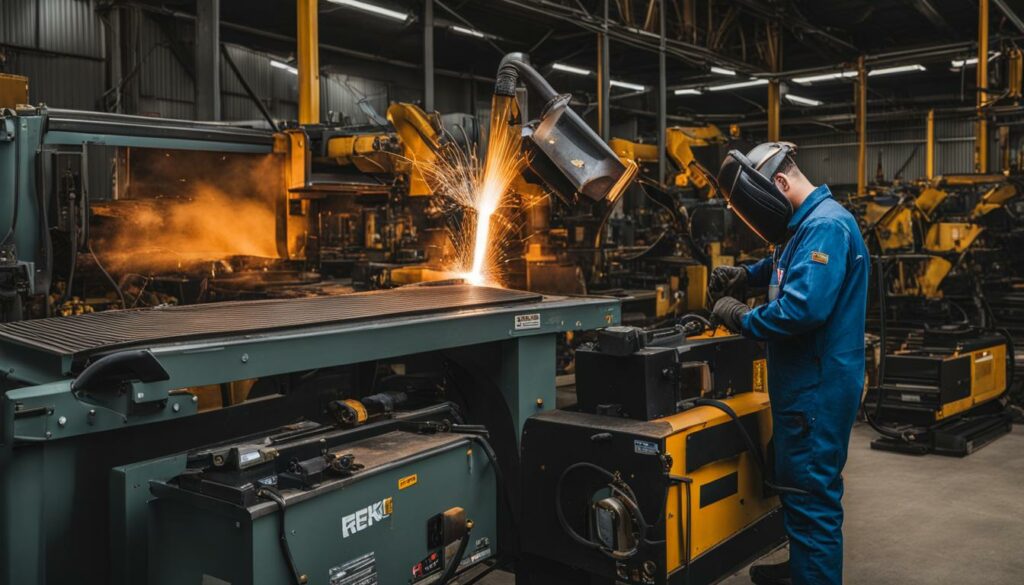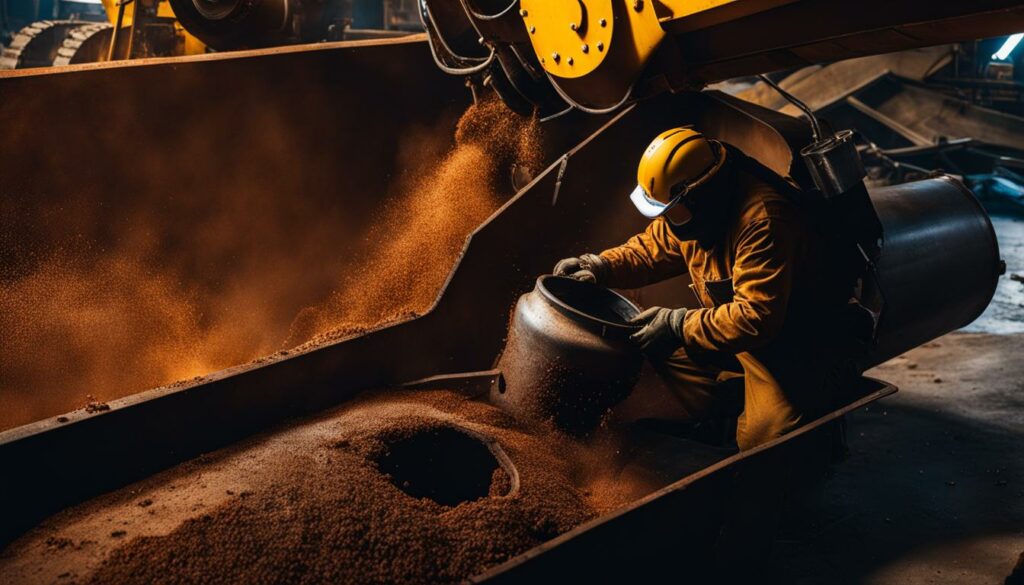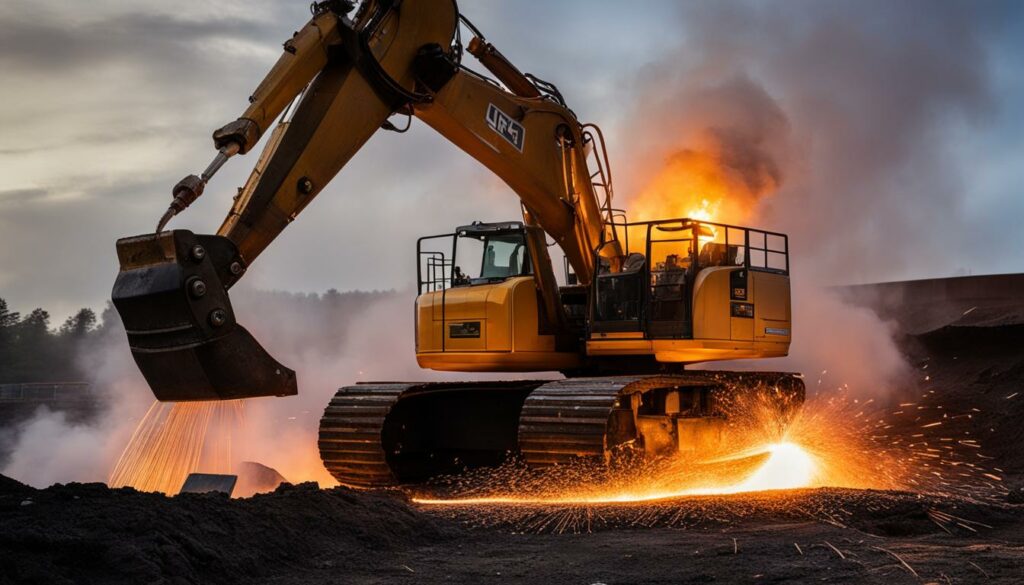To become a skilled welder in heavy machinery, it is crucial to understand that practice is key. Reading books can only take you so far, but hands-on experience is what truly allows you to master the techniques. Whether you have a natural talent for welding or not, consistent practice is necessary for proficiency. Learning to weld heavy machinery requires dedication and persistence, but the rewards are worth it.
Key Takeaways:
- Practice is crucial for becoming skilled in heavy machinery welding.
- Invest in high-quality welding equipment suited for heavy machinery.
- Overcome welding challenges through expertise and specialized techniques.
- Prioritize safety by following proper protocols and using protective gear.
- Continuous learning and improvement are essential in the field of heavy machinery welding.
The Importance of Practice in Heavy Machinery Welding
When it comes to mastering the art of heavy machinery welding, practice is absolutely essential. Reading books and studying theory can only get you so far; it’s the hands-on experience that truly hones your skills. Regular practice allows you to develop welding techniques specifically tailored for heavy machinery, giving you the confidence and proficiency to tackle any welding project. So, roll up your sleeves, grab your welding equipment, and start practicing!
Through consistent practice, you’ll become familiar with different welding methods that are best suited for heavy machinery. This includes techniques such as shielded metal arc welding (SMAW), gas metal arc welding (GMAW), and flux-cored arc welding (FCAW). Each method has its own advantages and applications, and by practicing with them, you’ll be able to choose the most suitable technique for each welding project.
Furthermore, regular practice allows you to improve your efficiency and the quality of your welds. With time, you’ll develop better hand-eye coordination, ensuring precise and accurate welds. You’ll also gain a better understanding of the welding parameters, such as voltage and wire feed speed, and how they affect the weld quality. This knowledge will help you make adjustments on the fly to achieve the desired results.
The Benefits of Regular Practice in Heavy Machinery Welding
There are several benefits to regular practice in heavy machinery welding:
- Improved proficiency and confidence in welding techniques
- Better understanding of different welding methods
- Enhanced efficiency and quality of welds
- Opportunity to experiment with different welding parameters
- Increased ability to tackle complex welding projects
By dedicating time to regular practice, you’ll not only improve your welding skills but also gain a deeper understanding of the welding process as a whole. So, don’t be afraid to get your hands dirty and embrace the learning journey that comes with practicing heavy machinery welding.
Choosing the Right Equipment for Heavy Machinery Welding
When it comes to heavy machinery welding, having the right equipment is crucial for achieving quality and efficiency in your work. Investing in high-quality welding machines and protective gear is a key aspect of ensuring successful welds on heavy machinery.
One of the primary considerations when choosing welding equipment for heavy machinery is the type of welding process. MIG (Metal Inert Gas) welders are commonly used for heavy machinery welding due to their versatility and ability to handle thicker materials. TIG (Tungsten Inert Gas) welders, on the other hand, are favored for their precise control and clean welds, making them suitable for intricate and detailed work on heavy machinery.
In addition to choosing the right welding machine, selecting the appropriate welding electrodes is essential. Electrodes come in various types and sizes, each designed for specific applications and materials. Understanding the characteristics of different electrodes will help you achieve the desired weld quality and penetration on heavy machinery.
| Welding Machine | Advantages | Disadvantages |
|---|---|---|
| MIG Welder | Versatile, high productivity, suitable for thick materials | Less suitable for precise and detailed work |
| TIG Welder | Precise control, clean welds, suitable for intricate work | Lower productivity compared to MIG welding |
Furthermore, it is essential to prioritize safety by investing in proper protective gear. A high-quality welding helmet with an auto-darkening feature will protect your eyes from harmful UV rays and provide clear visibility during welding. Heat-resistant gloves, welding aprons, and ear protection are also crucial for safeguarding yourself while working on heavy machinery.
By carefully selecting the right welding equipment and protective gear, you can ensure your safety, enhance your welding efficiency, and achieve excellent results when working on heavy machinery.

Overcoming Welding Challenges in Heavy Machinery
Welding heavy machinery presents its own set of challenges that require expertise and specialized techniques. The intricacies of heavy machinery, such as thick materials and complex structural components, demand effective welding methods to ensure strong and durable welds. Here are some key tips to help you overcome welding challenges in heavy machinery:
1. Heat Distortion Management
One of the major challenges in heavy machinery welding is heat distortion due to the thickness of the materials. This can lead to warping and misalignment of components. To mitigate heat distortion, consider preheating the parts before welding to reduce temperature differentials. Proper planning and sequencing of welds, as well as the use of heat sinks or heat control techniques, can also help manage heat distribution and minimize distortion.
2. Limited Access Welding
Another challenge is the limited access to certain areas of heavy machinery. It may be difficult to reach tight spaces or weld in hard-to-reach positions. In such situations, innovative welding techniques like robotic welding or the use of specialized welding tools can help overcome limited access challenges. These technologies enable accurate and efficient welding in confined spaces, ensuring that all critical components are properly welded.
3. Joint Preparation and Cleaning
The quality of welds in heavy machinery largely depends on proper joint preparation and cleaning. The welding surfaces must be free from contaminants such as oil, grease, rust, and paint. Thorough cleaning and proper joint preparation, including beveling and chamfering, promote better fusion and improve the overall weld integrity. Be sure to follow prescribed cleaning procedures and use appropriate cleaning agents for optimal results.
| Common Welding Challenges | Effective Solutions |
|---|---|
| Heat distortion | Preheating, sequencing welds, heat sinks |
| Limited access | Robotic welding, specialized tools |
| Joint preparation and cleaning | Thorough cleaning, beveling, chamfering |
“Overcoming welding challenges in heavy machinery requires a combination of technical knowledge, innovative techniques, and hands-on experience. By understanding these common challenges and implementing effective solutions, you can ensure high-quality welds and reliable performance of heavy machinery.”
By continuously expanding your welding expertise and staying up-to-date with industry advancements, you can successfully tackle the challenges encountered in heavy machinery welding. Remember that overcoming these challenges requires a combination of technical knowledge, innovative techniques, and hands-on experience. With dedication and practice, you can become proficient in welding heavy machinery and ensure the longevity and reliability of your welds.

Ensuring Safety in Heavy Machinery Welding
When it comes to heavy machinery welding, prioritizing safety is of utmost importance. Working with large and powerful equipment poses various risks, including electrical hazards, fire, and exposure to harmful fumes and gases. By following best practices and adhering to safety guidelines, you can protect yourself and ensure the longevity and durability of your welds.
One of the key safety measures in heavy machinery welding is wearing appropriate personal protective equipment (PPE). This includes a welding helmet with an auto-darkening feature to shield your eyes from intense light and harmful radiation. Additionally, wearing flame-resistant clothing, gloves, and steel-toed boots can safeguard you from potential burns and injuries.
Regular inspections of your welding equipment are vital for identifying any issues or defects that could compromise safety. Make sure to check cables, connections, and electrodes for signs of damage or wear. It is also crucial to maintain proper ventilation in your work area to prevent the accumulation of hazardous gases and fumes. Adequate ventilation helps ensure a safe and healthy environment for both you and your colleagues.
Remember, safety should never be compromised in heavy machinery welding. Taking the necessary precautions and investing in quality safety equipment will protect you and help you achieve exceptional results.
By taking safety seriously and implementing best practices, you can create a secure working environment and prevent accidents or injuries. Remember, your well-being and that of others should always be the top priority in heavy machinery welding.
| Key Safety Measures | Explanation |
|---|---|
| Personal Protective Equipment (PPE) | Wear a welding helmet, flame-resistant clothing, gloves, and steel-toed boots to protect yourself from hazards. |
| Equipment Inspections | Regularly check cables, connections, and electrodes for any signs of damage or wear that could compromise safety. |
| Ventilation | Maintain proper ventilation in the work area to prevent the accumulation of hazardous gases and fumes. |
Expert Tips and Tricks for Heavy Machinery Welding
When it comes to heavy machinery welding, experienced welders have a wealth of tips and tricks to share. These insights can help you refine your skills, improve efficiency, and achieve high-quality welds. Here are some expert recommendations to take your heavy machinery welding to the next level:
1. Adjust Welding Parameters for Different Materials
Each material used in heavy machinery welding requires specific welding parameters to achieve optimal results. Experiment with different settings for different materials, such as steel, aluminum, and stainless steel, to determine the ideal heat input, travel speed, and filler wire selection. Fine-tuning your welding parameters based on the material being welded will enhance the overall quality and strength of your welds.
2. Use Specialized Techniques for Challenging Welding Positions
Heavy machinery often includes components that are difficult to access or require welding in challenging positions. To overcome these obstacles, consider using specialized techniques such as back-stepping, staggered welding, or the use of welding positioners. These techniques can make welding in confined spaces or awkward positions more manageable and ensure consistent weld quality throughout the entire joint.
3. Prioritize Joint Preparation
The quality and strength of a weld heavily rely on joint preparation. Before welding heavy machinery, take the time to properly clean and prepare the joint surfaces. This includes removing any dirt, rust, or contaminants, as well as ensuring precise fit-up and alignment. Well-prepared joints provide a solid foundation for successful welds, reducing the likelihood of defects and improving overall weld integrity.
4. Employ Pre- and Post-Heat Techniques
In certain cases, pre- and post-heating can be beneficial for heavy machinery welding. Pre-heating can help reduce the risk of cracking and improve weld fusion, especially when working with thick materials. Post-heating, on the other hand, can relieve residual stresses and increase the durability of the weld. Consult industry guidelines and consider implementing these techniques when necessary to enhance weld quality and longevity.
5. Seek Continuous Learning Opportunities
Even experienced welders should never stop learning. Stay up-to-date with the latest advancements in heavy machinery welding by attending workshops, seminars, and industry conferences. Continuously expanding your knowledge and skill set will keep you informed about new techniques and technologies that can improve your welding efficiency and expertise.
| Tips | Benefits |
|---|---|
| Adjust welding parameters for different materials | Optimal weld quality and strength |
| Use specialized techniques for challenging welding positions | Improved access and consistent weld quality |
| Prioritize joint preparation | Enhanced weld integrity and reduced defects |
| Employ pre- and post-heat techniques | Reduced risk of cracking and improved weld durability |
| Seek continuous learning opportunities | Stay updated with industry advancements and improve welding expertise |
Continuous Learning and Improvement in Heavy Machinery Welding
Mastering the art of heavy machinery welding requires more than just practice and experience. It also demands a commitment to continuous learning and improvement. In this constantly evolving field, it is essential to stay updated on the latest welding technologies, techniques, and industry advancements.
Attending workshops, seminars, and industry conferences can provide valuable opportunities to expand your knowledge and skills in heavy machinery welding. These events often feature experts who share their expertise and offer valuable insights and advice. By actively participating in these learning opportunities, you can stay at the forefront of the industry and enhance your welding expertise.
Additionally, keeping up with industry publications, online forums, and social media groups can help you stay informed about new trends and developments in heavy machinery welding. Engaging with other welders and professionals in the field can provide valuable networking opportunities and foster the exchange of ideas and best practices.
| Benefits of Continuous Learning and Improvement in Heavy Machinery Welding |
|---|
| 1. Enhanced welding expertise |
| 2. Keeping up with industry advancements |
| 3. Networking opportunities |
| 4. Access to expert advice and insights |
| 5. Staying ahead of the competition |
By embracing a mindset of continuous learning and improvement, you can ensure that your heavy machinery welding skills remain sharp and up-to-date. This commitment to ongoing education will not only benefit your own professional growth but also contribute to the quality and durability of your welds on heavy machinery.
Conclusion
Mastering heavy machinery welding requires dedication, practice, and a commitment to safety. By investing in high-quality equipment, continuously improving your skills, and learning from experienced welders, you can become a skilled professional in heavy machinery welding.
Remember that welding is a trade that requires hands-on experience, so get out there, burn rod, and keep practicing. Your hard work and expertise will pay off in the form of strong and durable welds on heavy machinery.
With each weld, you refine your techniques and gain valuable insights that only firsthand experience can provide. Embrace the challenges and opportunities that come with welding heavy machinery, and always prioritize safety in your work. By staying dedicated and committed to continuous improvement, you can elevate your welding skills and establish yourself as a trusted expert in the field.
FAQ
Why is practice important in heavy machinery welding?
Practice is essential in heavy machinery welding because it allows you to develop welding techniques specifically suited for the task. Consistent practice helps you enhance your efficiency, improve the quality of your welds, and understand the safety precautions necessary when working with heavy machinery.
What equipment is needed for heavy machinery welding?
To weld heavy machinery, it is important to invest in high-quality welding machines such as MIG or TIG welders. Additionally, selecting the right welding electrodes and protective gear, such as helmets and gloves, is crucial for ensuring both safety and efficiency in the welding process.
What challenges are involved in welding heavy machinery?
Welding heavy machinery presents challenges such as working with thick materials, complex structural components, heat distortion, limited access, and joint preparation. Overcoming these challenges requires expertise and specialized techniques.
How can safety be ensured in heavy machinery welding?
Safety is of utmost importance in heavy machinery welding. Following safety protocols, such as wearing appropriate personal protective equipment, regularly inspecting welding equipment, and ventilating work areas properly, ensures the longevity and durability of your welds and protects you from hazards such as electrical shock, fire, and exposure to fumes and gases.
What tips and tricks can other experienced welders offer for heavy machinery welding?
Seasoned welders who have extensive experience in heavy machinery welding often have valuable tips and tricks to offer, including adjusting welding parameters for different materials and using specialized techniques for specific welding positions. Learning from experts and incorporating their advice into your own practice can significantly enhance your welding skills and lead to more efficient and successful welds on heavy machinery.
How can I continuously improve my skills in heavy machinery welding?
The field of welding is constantly evolving, so it is essential to continuously learn and improve your skills. This can be achieved through attending workshops, seminars, and industry conferences, as well as staying updated on new welding technologies and techniques. Embracing a mindset of continuous learning and improvement will help you enhance your expertise and stay at the forefront of the heavy machinery welding industry.

